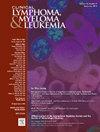在多发性骨髓瘤骨干治疗方案中加入埃洛珠单抗:随机临床试验的最新Meta分析。
IF 2.7
4区 医学
Q2 HEMATOLOGY
引用次数: 0
摘要
研究背景在随机对照试验(RCT)中,抗SLAMF7单克隆抗体埃洛珠单抗治疗复发/难治性多发性骨髓瘤(RRMM)和新诊断多发性骨髓瘤(NDMM)的疗效各不相同。此外,有关其在现实世界中应用的数据也很有限:我们对研究在骨干抗骨髓瘤方案中添加埃洛珠单抗的随机对照试验进行了系统回顾和荟萃分析。主要研究结果为无进展生存期(PFS)。次要疗效结果包括总生存期(OS)、总反应率(ORR)和非常好或更好的部分反应率(VGPR)。此外,还对主要毒性进行了评估:结果:纳入了3项RRMM试验(n = 915)和5项NDMM试验(n = 1790),2705名患者中有50%接受了含伊洛珠单抗的三联或四联疗法。在RRMM环境中,使用埃洛珠单抗可显著改善PFS(危险比[HR],0.70;95%置信区间[CI],0.60-0.82;P < .001;I² = 0%)。高危细胞遗传学患者也能从中获益(HR,0.62;95% 置信区间 [CI],0.43-0.90;P = .01;I² = 0%),这在之前接受过蛋白酶体抑制剂(PI)或免疫调节药物(IMiD)治疗的患者中尤为明显。RRMM队列还显示出更好的OS、ORR和≥VGPR率。然而,NDMM队列在任何疗效结果方面均无明显改善。尽管严重感染(≥3级)有所增加,但使用埃洛珠单抗并未对严重细胞减少症、严重心脏疾病或第二原发性恶性肿瘤的发生率产生不利影响:我们的研究结果表明,对于暴露于PI/IMD的RRMM患者来说,含有伊洛珠单抗的治疗方案是有价值的治疗选择。相比之下,埃洛珠单抗在一线治疗中的作用仍然有限。本文章由计算机程序翻译,如有差异,请以英文原文为准。
Addition of Elotuzumab to Backbone Treatment Regimens for Multiple Myeloma: An Updated Meta-Analysis of Randomized Clinical Trials
Background
The efficacy of elotuzumab, an anti-SLAMF7 monoclonal antibody, in treating relapsed/refractory multiple myeloma (RRMM) and newly-diagnosed multiple myeloma (NDMM) has varied in randomized controlled trials (RCTs). Moreover, there is limited data on its real-world application.
Patients and Methods
We conducted a systematic review and meta-analysis of RCTs investigating the addition of elotuzumab to backbone antimyeloma regimens. The primary outcome of interest was progression-free survival (PFS). Secondary efficacy outcomes included overall survival (OS), overall response rate (ORR), and rates of very good partial response or better (VGPR). Key toxicities were also evaluated.
Results
Three RRMM trials (n = 915) and 5 NDMM trials (n = 1790) were included, with 50% of the 2705 patients receiving elotuzumab-containing triplets or quadruplets. In RRMM settings, elotuzumab use significantly improved PFS (hazard ratio [HR], 0.70; 95% confidence interval [CI], 0.60-0.82; P < .001; I² = 0%). This benefit was consistent among patients with high-risk cytogenetics (HR, 0.62; 95% CI, 0.43-0.90; P = .01; I² = 0%) and was particularly evident in those previously treated with proteasome inhibitors (PIs) or immunomodulatory drugs (IMiDs). The RRMM cohort also demonstrated better OS, ORR, and ≥VGPR rate. However, the NDMM cohort showed no significant improvements in any efficacy outcomes. Despite an increase in severe (grade ≥3) infections, elotuzumab use did not adversely affect rates of severe cytopenias, severe cardiac disorders, or second primary malignancies.
Conclusion
Our results suggest that elotuzumab-containing regimens represent valuable therapeutic options for PI/IMiD-exposed patients with RRMM. In contrast, elotuzumab's role in frontline settings remains limited.
求助全文
通过发布文献求助,成功后即可免费获取论文全文。
去求助
来源期刊

Clinical Lymphoma, Myeloma & Leukemia
ONCOLOGY-HEMATOLOGY
CiteScore
2.70
自引率
3.70%
发文量
1606
审稿时长
26 days
期刊介绍:
Clinical Lymphoma, Myeloma & Leukemia is a peer-reviewed monthly journal that publishes original articles describing various aspects of clinical and translational research of lymphoma, myeloma and leukemia. Clinical Lymphoma, Myeloma & Leukemia is devoted to articles on detection, diagnosis, prevention, and treatment of lymphoma, myeloma, leukemia and related disorders including macroglobulinemia, amyloidosis, and plasma-cell dyscrasias. The main emphasis is on recent scientific developments in all areas related to lymphoma, myeloma and leukemia. Specific areas of interest include clinical research and mechanistic approaches; drug sensitivity and resistance; gene and antisense therapy; pathology, markers, and prognostic indicators; chemoprevention strategies; multimodality therapy; and integration of various approaches.
 求助内容:
求助内容: 应助结果提醒方式:
应助结果提醒方式:


